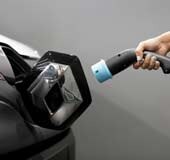Buying an EV? Understand battery, motor and regen braking
The main components of electric vehicles are battery and motor. Out of these, batteries are undergoing most experiments these days. All EV companies are experimenting to come up with smaller and more efficient batteries. Let’s understand all about batteries and motors used in EVs.
Except for some rare electric scooters, all other electric vehicles use lithium-ion batteries. There are different types of batteries depending on the compounds used. Early lithium-ion batteries had a cathode made of lithium cobalt oxide and a graphite anode. Experiments with flame retardants have led to the use of other compounds of lithium.
Lithium ferro phosphate, lithium manganese oxide, and lithium nickel manganese cobalt oxide are currently popular among them. Each differs in terms of its ability to accumulate charge, resist fire and remain operational for a long time.
Battery design
Battery designs are also of various types. A battery is made up of many lithium-ion cells. A battery is usually manufactured in the form of small and large cylindrical cells, thin flat casing, rectangular and thick box.
Battery management system
Each cell will be equipped with an electronic monitoring system. A centralized electronic control unit called battery management system works by collecting data from these (voltage variation, charging rate).
Battery companies
Chinese giant CATL is the leading manufacturer of lithium-ion batteries. This company, which has a 34% share of the global market, provides batteries to Tesla. Its main product is lithium ferro phosphate battery pack. LG, the second-ranked Korean company, produces more lithium manganese oxide battery cells in the form of thin pouches.
At the third position is Chinese company BYD, which is now selling electric vehicles (E6 and Atto 3) in India. Their blade design lithium ferro phosphate batteries are renowned in the global market for their excellent performance. Most EV manufacturers in India have tied up with BYD to purchase batteries. However, Tata has announced that it will start a factory in Gujarat to manufacture its own lithium-ion batteries.
Currently, lithium ferro phosphate batteries are in the forefront. Although the power density is a little less, the risk of fire and the cost is less. As the amount of available lithium is limited, efforts are being made to replace it with sodium-ion batteries. Instead of the liquid electrolyte in the current batteries, more efficient batteries that use solid electrodes made of nanotechnology have reached the experimental stage.
Motors
An electric vehicle (EV) is powered by a motor. DC and AC motors are used for this. In the early days DC series motors were used. However, due to wear and tear of the commutator and brushes in these, they became less practical and were withdrawn.
BLDC motor
A brushless DC motor (BLDC) that does not use brushes is now widely used in two-wheel electric vehicles. It is used either as a hub motor directly coupled to the wheel (eg TVS iCube) or as a motor mounted on the wheel with a toothed belt (eg Ather). Tesla uses a complex type of DC motor. Regenerative braking can be done very efficiently when using this permanent magnet reluctance motor.
Induction motors run on AC current. Not only do they have high efficiency and excellent durability, but they are also cheap. However, there is a disadvantage that the initial torque is less. Tesla’s Model S uses this type of motor. Tata and TVS are trying to use induction motors in their EVs. Apart from this there is another type of AC motor called permanent magnet synchronous motor (PMSM). It produces smooth torque unlike a typical induction motor and is used in newer generation EVs (eg BYD E6).
Regenerative braking
Regenerative braking is a key feature of EVs. In a normal vehicle, when the brake is used to slow down, the kinetic energy is converted into heat through friction in the brake system. However, in EVs, it is possible to recover a good portion of this lost energy to charge the battery. When the propulsion motor acts as a generator using the vehicle’s kinetic energy, it decelerates and produces electricity, which flows back to the battery. This is called regenerative braking.
When the driver takes his or her foot off the accelerator or steps on the brake, the EV’s electronic control system slows down the motor and uses the generated electricity to charge the battery. The intensity of this process (the amount of regenerative braking) can be regulated in many vehicles. At the strongest level it is possible to accelerate as well as brake using only the accelerator. This is called ‘single pedal driving’.
For all the latest business News Click Here

